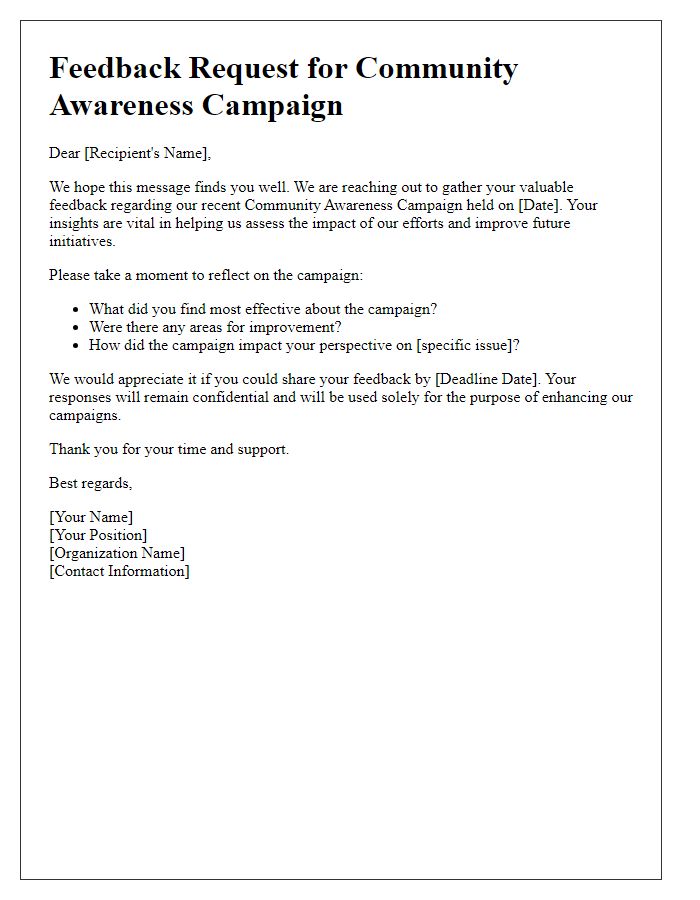Are you passionate about making a difference in our community? We believe that raising awareness is the first step to driving change, and that's where our upcoming campaign comes in! With a few simple actions, we can empower each other and create a positive impact together. Join us in exploring how you can contributeâread more about our initiative and get involved!

Target Audience Identification
Identifying target audiences for community awareness campaigns is crucial for effective message dissemination. Groups may include local residents in neighborhoods such as Riverside and Maplewood, schools like Lincoln High School, and organizations such as the United Way. Special attention to demographics such as age groups--youth (ages 13-18), working adults (ages 19-65), and seniors (ages 65 and older)--ensures tailored messaging. Engagement with specific community leaders or influencers, such as local business owners or non-profit directors, can amplify reach. Understanding unique characteristics, including cultural backgrounds, languages spoken, and prevalent local issues (e.g., homelessness, youth empowerment), allows for more impactful and relatable communication strategies.
Clear Purpose Statement
A community awareness campaign seeks to inform residents about local environmental issues, such as pollution levels in nearby rivers and the impact of plastic waste on wildlife. This initiative aims to educate families and individuals on sustainable practices, including recycling methods and participation in cleanup events, scheduled throughout the year. Engaging local schools, businesses, and organizations fosters a united approach toward addressing these challenges, with events planned at popular community venues like Central Park Pavilion. The campaign encourages active involvement, empowering citizens through workshops and informational pamphlets that outline actionable steps to promote a cleaner, healthier community for future generations.
Concise and Impactful Message
Community awareness campaigns often rely on clear and powerful messaging to inform residents about crucial issues. Messages should focus on specific topics such as environmental conservation, public health threats like the flu season, or safety measures during events like natural disasters. For example, the campaign could target youth in urban areas, educating them about the importance of recycling to reduce landfill waste, specifically emphasizing that reducing waste by just 10% could extend the life of local landfills by several years. Visual aids, such as infographics showing the increase in pollution levels in nearby rivers due to littering, can bolster the impactful message and encourage participation from the community.
Call to Action
Community awareness campaigns play a crucial role in mobilizing citizens towards collective action. Engaging individuals in various initiatives, such as environmental sustainability (like planting trees in Central Park, NYC), public health awareness (promoting vaccinations during flu season), and social issues (supporting local homeless shelters), fosters a sense of responsibility. Encouraging participation can include organizing community meetings, distributing informational flyers, or utilizing social media platforms (like Facebook groups specific to neighborhood concerns) to spread the message. These actions help build a unified front around important issues, ultimately driving positive change within the community and empowering citizens to take an active role in shaping their environment.
Contact Information and Resources
Community awareness campaigns require effective communication strategies to engage the public. Contact information must be clear, including phone numbers, email addresses, and social media handles (for example, a Facebook page dedicated to local events). Resources should focus on educational materials such as brochures, flyers, and guidelines published by health organizations like the World Health Organization and Centers for Disease Control and Prevention, providing crucial information on local issues. Venues for community meetings, such as local libraries or community centers, should be noted with specific addresses and times, facilitating increased participation. Accessibility resources for individuals with disabilities must also be highlighted, ensuring inclusive engagement across diverse populations.













Comments